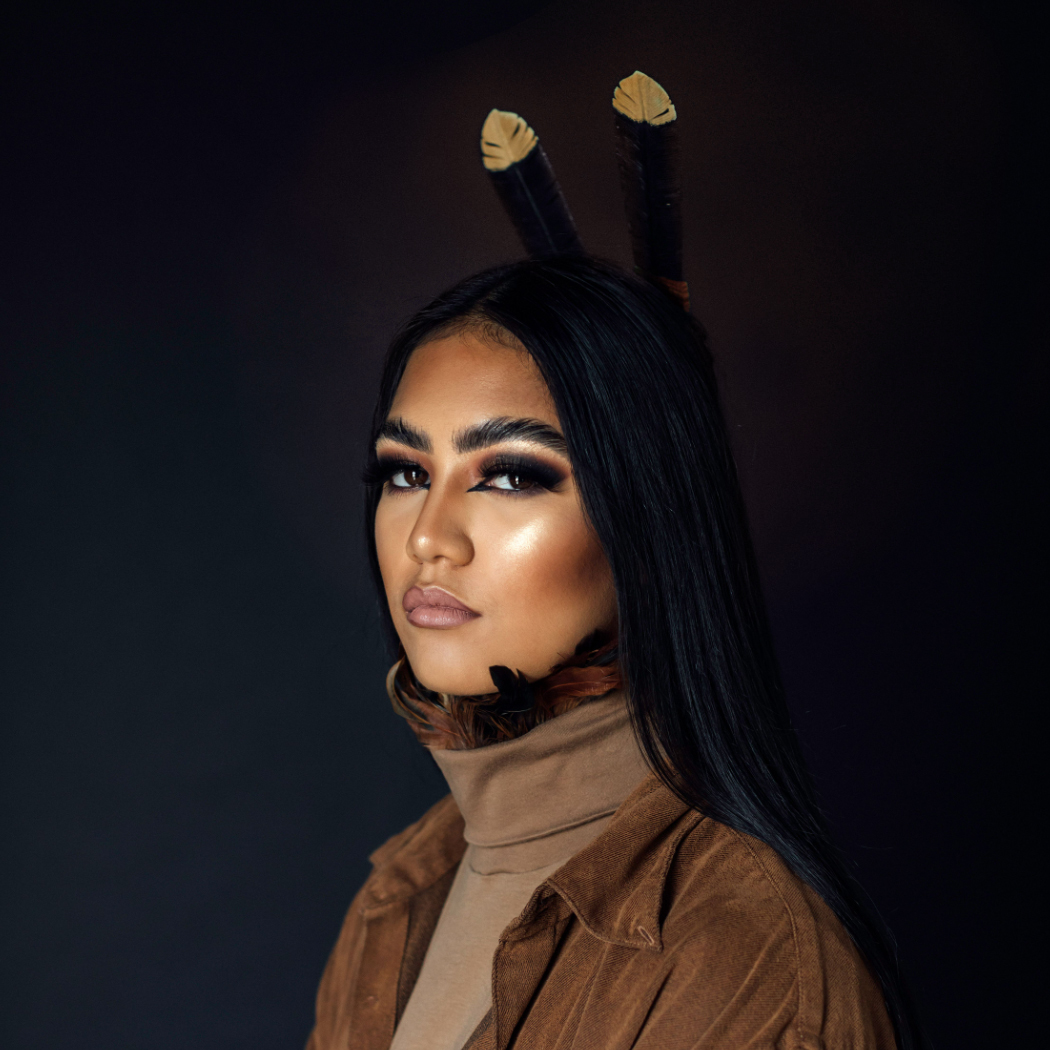
Hinauri Nehua-Jackson (@hinaurinehua). Photo by Noella Steinhauer. Makeup by Amanda Steinhauer
Hinauri Nehua-Jackson is a 19-year-old Māori/Korean activist-model from Aotearoa, New Zealand. She has a passion for art, design, learning new languages, and camping in the mountains.
She is an Indigenous advocate and a second-generation woman of the Māori language movement. Her work includes cultural revitalization through fashion and educating colleagues on Māori issues, and Indigenous issues on Turtle Island.
Hinauri models on the runway and for commercial and editorial photoshoots. She has been featured in Vogue, ELLE Canada, and Complex and has been on the runway at Western Canada Fashion Week, Indigenous Fashion Week, and Black History Month fashion shows, as well as the Indigenous Empowerment Collective, which she co-founded with her mother and two younger sisters.
A proud takatāpui (two-spirited) person, Hinauri plans to create a fashion line of gender-bending clothing to engage people in conversation. She also advocates for visual representation for people of mixed ancestry, “so that future generations can think greater, dream bigger, and be unapologetically raw and real in the world.”
Why do you model?
Modeling makes me happy.
As a child, I naturally confined myself into small spaces where no eyes or sound could reach me. Creative outlets like art, classical music and performing kapa haka (traditional Māori dances) helped me find a voice to express how I felt. Then, I was about seven years old, my mother gave me the opportunity to walk for her close friend Jeanine Clarkin, a pioneer of Māori fashion design in Aotearoa. The first time I walked on the runway, I was very nervous—but then I found confidence. I remember little Hinauri in that limelight moment, feeling genuinely happy and comfortable, and—for the first time—comfortable in her own skin.
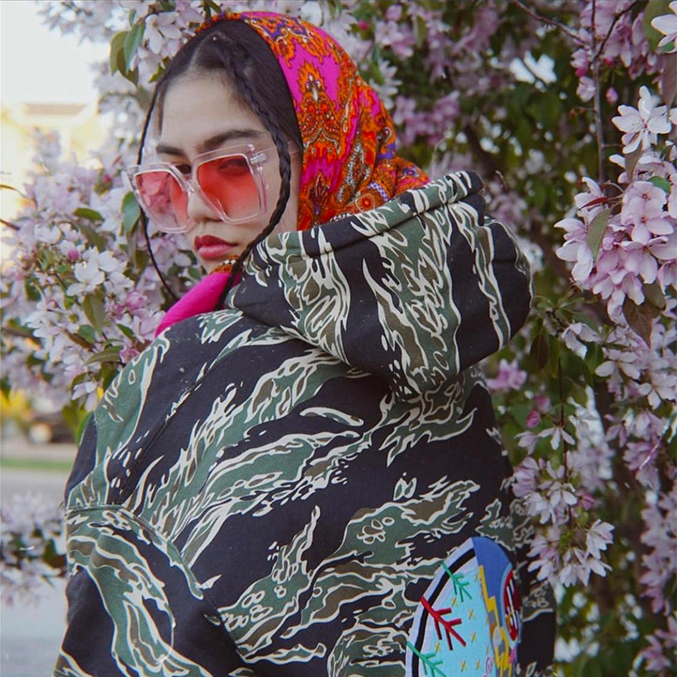
Designers: @m.o.b.i.l.i.z.e @jordanbennettart
Photographers: @cheyennerainlegrande @menorphoto
Stylist: @cheyennerainlegrande
What do you enjoy most in modeling and fashion?
As a model, I love, love, love editorial shoots. They give me the opportunity to think bigger than ever and to execute an emotion or an elevated form of the client’s vision. For me as an everyday person, I like designing and styling my own outfits as a form of art and expression—I find this uplifting and positive.
Also, I’m a proud takatāpui person, and in the future will be creating a sustainable fashion line of gender-bending clothing to engage people in conversation while adding visual cultural designs from my Māori side.
It humbles me every time I get a modeling job because in my eyes, the client is giving me an important responsibility. They’ve chosen me and my craziness to reflect and exaggerate their artform in such a way that could not be possible with other models.
As a creator, as an artist, I see it as a form of expression—for myself, as an artist, and for the people I’m modeling for. The designers want someone who can embody and “sell” their design—and the dream. I see it as a lot like acting.
Can you explain takatāpui? Is it like two-spirited?
Yes. Takatāpui are gifted to walk both paths.
I would define takatāpui as an umbrella term for anyone in the LGBTQ+ community. For me personally, it would be a Māori person who is gifted to not only love the same gender, but to also gravitate towards all gender-based roles allocated in the Māori community.
Today, Māori are taught to do only a select set of things according to their assigned or assumed gender, which limits their choices. But the word takatāpui is in one of the first Māori dictionaries, so we were embraced in traditional Māori society before colonialization.
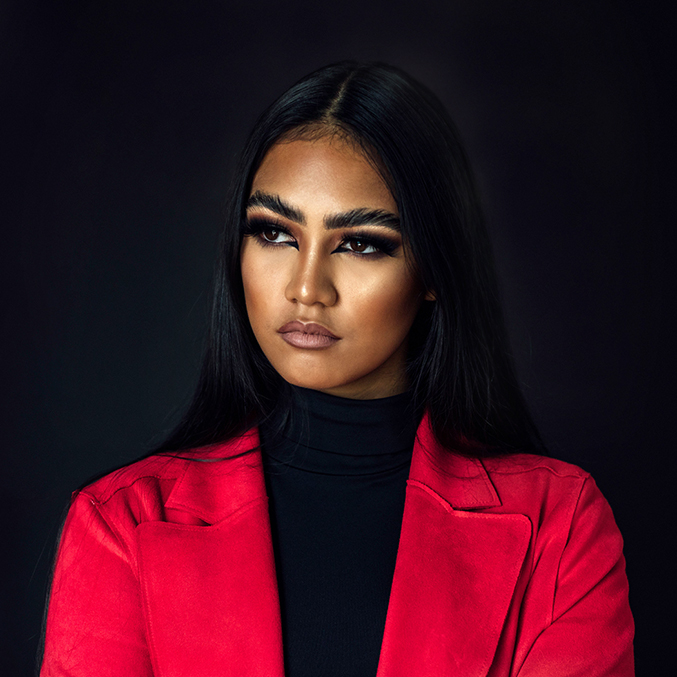
Hinauri Nehua-Jackson. Photo by Noella Steinhauer. Makeup by Amanda Steinhauer
When did you first learn this about yourself?
The first time I remember experiencing feeling uncomfortable with a traditional gender-based role was in kapahaka (Māori performing arts), where males and females are separated and taught to perform beautifully based on their assigned genders. It was at this time I knew I was different, and I felt very isolated due to my wairua (spirit) having both a feminine and masculine energy. I knew I was physically born a female, but I always gravitated to the boys performing the haka or doing the male pukana (warrior face) more than the female pukana. Whenever I’ve had the opportunity to lead women in song and dance, I’ve felt like I’m only being true to half of myself.
To this day, I choose to not participate in any kapahaka due to the confusion it causes me and, in general, the lack of understanding for tangata takatapui (people who are two-spirited). Hopefully, when I become more aware of myself and my identity, I will take part in kapahaka once more.
Thank you for sharing that. It’s so important. I also think it is important to honor your mixed ancestry.
Yes, my father is Korean. I may not have the greatest relationship with him, but I still want to acknowledge his side because it provides me closure. It also helps me understand why I look, speak, and approach things differently than other tangata Māori (Māori people). Also, being part Asian has greatly impacted my life because many people welcomed me into their culture—mostly the Filipino, Chinese, and Japanese communities.
I learned about my Korean heritage only three years ago, and I’ve made a goal to better understand Korean language and culture, in order to better understand myself. Someday, I hope to learn how to put on a beautiful hanbok (traditional Korean clothing) by myself.
I am a big advocate of visual representation for people of mixed ancestry so that future generations can think greater, dream bigger, and be unapologetically raw and real in the world.
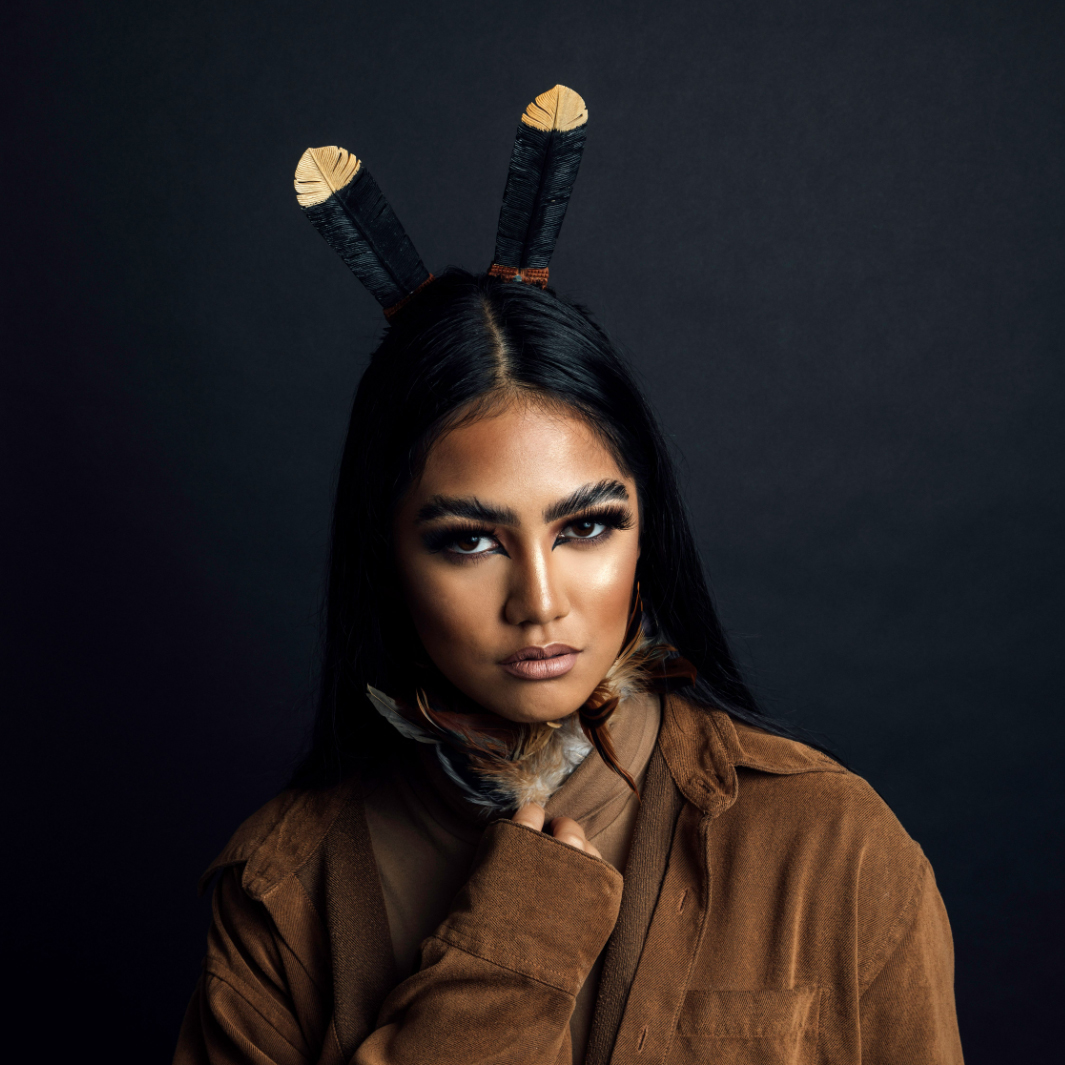
Hinauri Nehua-Jackson. Photo by Noella Steinhauer. Makeup by Amanda Steinhauer
Have you ever experienced the problem of being fetishized?
The number of times people fetishize our beings as Māori people can be quite agitating—and when I’m not fetishized for being Māori, I’m fetishized for being Korean!
Why is it important to remain independent, rather than sign with an agency?
The opportunities for a model in the BIWOC category are limitless. This is our time.
However, representation with an agency can be somewhat limited. Many of my model brothers and sisters have gotten the short end of the stick with agency representation. By working by myself, for myself, I have total control of my clients and rates, as well as my time.
With help and guidance from my mother and peers, I have developed the ability to network and to connect with collaborators and clients on my own, and this has taught me to look at the pros and cons of agency representation. When I’m home from this trip to New York, I may look for an agency that will represent me well. I am open to the idea.
How do you see yourself as White Wolf Woman?
White Wolf Woman is the Spirit name that the Indigenous people of Turtle Island at the International Sun Dance gave to me on my 16th birthday.
In the Cree Medicine Wheel, which is also known as the Sacred Hoop and the Sun Dance Circle, the color white symbolizes a spiritual person who has a sense of connectiveness with other creations of the Great Spirit—a gateway to the physical and spiritual bridge.
The wolf, which is known to be wise with much strength, represented the person I was becoming—my present self—a lone wolf destined to take the journey on her own, and woman was to show everyone that I’m no longer a child and that I must take responsibility—not only for my actions in life, but also for this name, which carries a heavy responsibility.
Your grandmother is very important to you.
My pumama is the reason why I am a proud Māori woman and why I continue to take up colonial spaces, so we as Indigenous people may have an equal ground in the future.
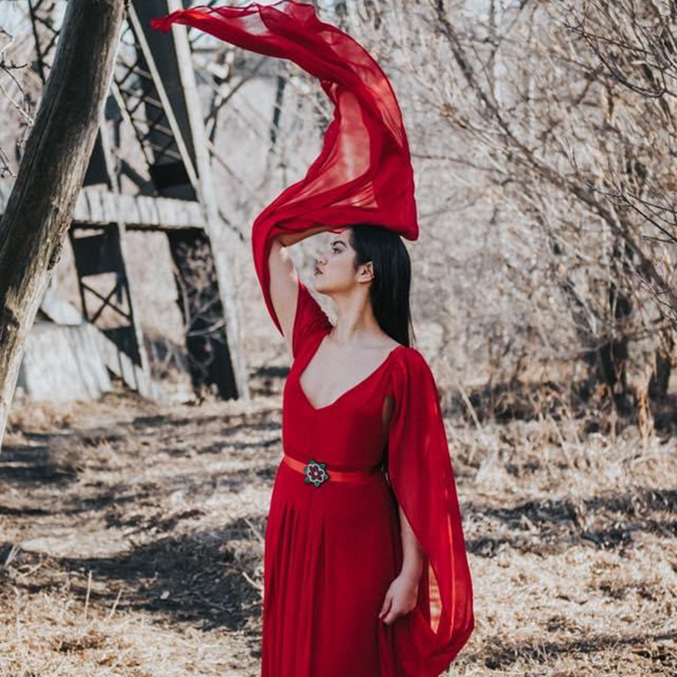
Hinauri Nehua-Jackson by Megan Kemshed
What does “taking up colonial spaces” mean to you?
Taking up colonial spaces can be as educating our non-Indigenous peers about Indigenous issues—things like (the Land Back movement, which is about putting land stolen by colonial forces back in Indigenous hands; the epidemic of Missing and Murdered Indigenous Women and Girls (MMIWG); the American and Canadian Indian Residential School systems, a silent genocide supported by both the government and the Roman Catholic church, through “normal” (normalizing?) discussions about activity re-educating and changing the approach of how the education systems view Indigenous people in the curriculum.
Taking up colonial spaces can also be representing my people on a New York Fashion Week runway, which creates conversation about Indigenous people and appearance in a cut-throat industry with deep colonial roots.
I understand that you have heard the call of medicinal plants and plant medicines?
Yes! I’m learning about traditional medicinal plants from Aotearoa and Turtle Island. The plants I continually work with and will someday grow are cedar and sweetgrass, due to their cleansing properties—physically, spiritually, and emotionally. They create a therapeutic state for mind, body, and spirit.
I’d like to continue to study rongoā (traditional Māori healing), as well as the First Nations healing traditions from Canada—but with respect for and acknowledgement of the two female elders who have taught me everything I know so far: my pumama (grandmother), Deidre Nehua, who taught me Māori medicine, and Bonny Spencer, a Métis elder and kohkum (Cree for grandmother), who is teaching me about her culture and medicines from Amiskwaciy Waskahikan, which is the indigenous name for Edmonton Alberta, Canada.
Is there a plant (or plants) from Aotearoa that you feel most connected to?
Harakeke (Phormium tenax) is the one that I gravitate to the most because of its many uses. It is native and unique to Aotearoa and is one of our oldest plant species.
Harakeke is a very important plant to Māori. My ancestors grew special varieties for color or softness or strength of fiber, and they made rope and clothing and fishing line and nets and many other life essentials with it.
I am in the process of making modern Māori art through fashion and sustainable fabric. I'd love to include Harakeke as a fiber, but being in Canada makes that quite difficult.
Harakeke is also is a rongoā medicinal plant that can be used for things like treating cuts, fighting infections, and binding wounds. And the nectar from the flowers is also a great sweetener.
It is a magical plant and one of the many things I miss about home.
How would you describe your personal style when you are not modeling someone else's vision?
If I could sum it up it would be called “Villain Era.”
It helps heal my inner child. As a young person, I was very gender fluid with my clothing, and I still love suits. I also loved wearing dark colors and shades of black—and that hasn’t changed. I feel I’m taking inspiration from little Hinauri but perfecting it to suit me now—"current me,” if that makes sense—which is more formal and elevated.
I’ve come to a point in my life where I love expressing myself through what I choose to wear. I’ve always seen villains as relatable because, for the most part, they are just misunderstood people, and that’s exactly what happens when I wear my outfits. I tend to get a lot of comments from peers that I can come off as “intimidating” or “dominant” due to how I hold myself when I’m wearing one of my outfits.
In a way, you are expressing different characters or aspects of yourself through what you wear?
Yes! Exactly. My clothing is armor. It gives me a sense of security when I’m in public spaces and allows me to release the confidence that lies within. Apparently, I can be quite intimidating when I’m wearing my “armor.”
What are some examples of favorite villains, antagonists and antiheroes who are stylish?
I’m starting with my Green Queen, who is the Wicked Witch of the West in the Wizard of Oz, and The Trix—three evil witch fairies from the animated series Winx Club—and antiheroine The Mistress of All Evil from the movie Maleficent and Catra from the cartoon She-Ra Princess of Power in the Masters of the Universe series. My favorite anime villains are Uchiha’s Itachi and Madara from Naruto Shippuden (a great storyline!). Also, the iconic Joker from Batman and Hades, Greek God of the Underworld (which is not “Hell”), who is another misunderstood “villain.”
You acted as a child. Does that in any way speak to your “Villain Era” look? Antagonists are often so much more fun to play - and they usually have better clothes, too!
Definitely. It’s that, oh, everyone doesn’t like this person. You know, that stereotypical storyline of, this is the good guy, and he’s done all these accomplishments, and here’s the villain, but we don’t talk about what the villain did. That sort of standard cliché villain.
I love the idea that the villain has the freedom to do whatever they want. I love that spirit of rebellion. And when I create my looks, I take a lot of pointers from ‘80s and ‘90s villains I’ve grown up with. Some of them aren’t really villains. They’re just powerful women. They know their worth, so they’re called villains. Just because women have that power in history doesn’t make them villains or witches.
Witches. Tell me more.
I love being a witch. Other than White Wolf Woman, I think “witch” is the greatest title I’ve been given. I’m so in love with natural medicines and plants and healing. I want to be an Indigenous healer, and back in the day, we used to be called witches, so I reclaimed the word “witch,” and I’ve made it my power word. The going in and out of worlds and the plants calling you and all of that. One look at this dark, feminine energy radiating from a woman, and they label you a witch.
Have you had any experience with the sacred psychedelic medicines? Like peyote or mushrooms or ayahuasca?
Not yet. I’ve been so focused on the modeling. But I’m definitely interested. I’m very open-minded to any medicine in the world that is indigenous and grown by Mother Earth and harvested by us.
I appreciate that you appreciate the behind-the-scene team.
Our success is a collective success because this is a collaborative artform—designers, models, photographers, makeup artists, and hairstylists all help create the final look.
Modeling doesn’t have to be superficial or ego-based. I have a lot of model students, and I always tell them, “If you really want to start modeling, you need to find a true purpose. It shouldn’t be about fame. If you really want to walk on certain runways, you need to really dig deep in yourself. Start off with those ‘why’ questions because if you have that understanding of yourself it will help you build your way up to where you want to be.”
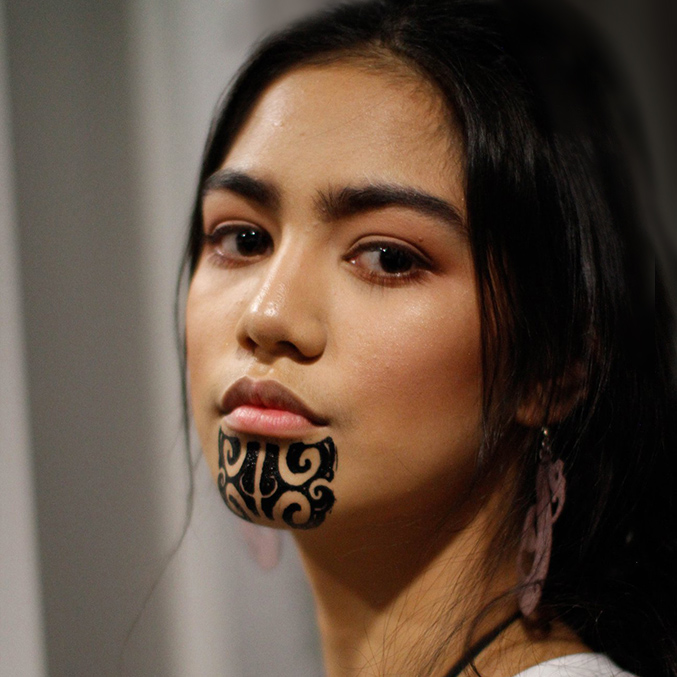
Hinauri Nehua-Jackson wearing her moko. Photo by Aaron Menor
Tell me about your moko in this photo.
The moko, or “moko kauae,” expresses one’s genealogy, family history, and life story. It is also about sisterhood, women’s rights, empowerment, and strength.
My grandmother was one of the first women to wear the moko in the post-colonial era. It represents a woman’s whānau (extended family) and honors her whakapapa (genealogy), as well as her skills and talents, knowledge, and status—it is a taonga (treasure).
When my mother selects models for fashion shows, she looks for people who are not only beautiful on the outside but also on the inside, and only individuals who understand the importance of the moko get to wear one. We also give the model a detailed history of the moko, why it is important, and the responsibilities that come with wearing one.
We use a custom-made stencil, and we purposely use bright colors such as pinks or blues to show a contemporary approach to the moko kauai.
I’m crazy about the photo of you with the feathers around your neck. I think that would make an amazing magazine cover.
When Sidney read the creative direction that you’d given her for the photoshoot to do a hipster, Indigenous New York look, I knew there had to be a black outfit, but I didn’t want it to be it be a plain-and-simple, cut-and-paste Hinauri, so I went back and meditated to classical music—I’m a big classical music person.
Tell me more about that.
Before I modeled, I was a classical musician. I would hyper-analyze the music, and every time I’d have a moment with music, I’d get a feeling—and I’d be creating, maybe drawing or writing or designing in my head. I’m very artsy.
In a way, I’m playing off certain instruments to create different designs, and the classical piece had a slow climax, and it took me on a high journey, almost like I was on a rollercoaster. And then all of a sudden, there was this big, loud, bang at the end, but it was almost delicate, like it was flying up. And as I was flying up, I thought of feathers and how great would it be if I could sing, but that didn’t feel right, so I thought, feathers on my neck—perfect! And that’s how I got the idea.
I know that—at least for now—I’ve stopped being a singer and a pianist and a musician, but that is never going to leave my system or my being. Everything I’ve done up to now, creatively, has impacted how I work today as a model. For instance, I always work with music in terms of how I walk the runway. Sometimes on photoshoots, I’ll find a song that relates to what my shoot is going to be, and I’ll play it continuously so I can be in the zone, and I don’t think about anything else but that song.
You first started modeling in Aotearoa as a child. How was that?
I’ve been modeling since I was seven years old, and that’s when I first felt comfortable in my skin.
Back then, people were very openly racist, and I did experience a lot of that due to how I held myself as a child. I was very open and free, but I wasn’t the girl playing with Barbies. I’d be dangling from a tree or playing with worms because I was fascinated with earth. My fashion sense didn’t have an in-between. I would either be hyper feminine or extremely masculine in the way I dressed.
I believe that made me an easy target in a very English and French community. Looking back, I feel like I should have defended myself, but instead, I hid in my shell.
But I felt like the prettiest person because in that limelight moment, even though technically, it wasn’t about me. It was about the clothes. I felt so pretty, wearing clothes I would never wear in my own life, and it was so uncomfortably awesome!
This industry can be tough.
There’s a lot about this industry that is sick and twisted. I either speak the truth or I don’t speak at all.
The very first thing I tell my modeling students is, “If you’re going to get into this industry, you need to need to know the bad stuff before we talk about the good stuff. I will help you be prepared.”
I tell them all the negative stuff that they’re going to encounter out there–before they sign into an agency—so they’re not blindsided. I tell them that there are amazing opportunities but not to be seduced by this fluffy fantasy world without knowing what they’re stepping into. I have heard so many horror stories, so I feel protective. I’d rather lay it all on the table so they know about things like creepy photographers or creepy clients or predatory contracts.
I’m at this point in my career where I have to look at things and say, it’s not personal, but let’s take that into consideration and work on it. Fear of failing doesn’t worry me anymore because I have already failed. So many times. There’s always a meat-market reason. I have learned to look at things from several perspectives.
You got this!
I am a very, very stubborn brown woman. I want to grab life by the horns with both hands. I’m hungry for that success.
There is a lot that I want to achieve. The New York trip is a good foundation—but I push for more. I’ve noticed that about myself.
I’m focused on what’s important to me now, which is more representation, and on an international platform.